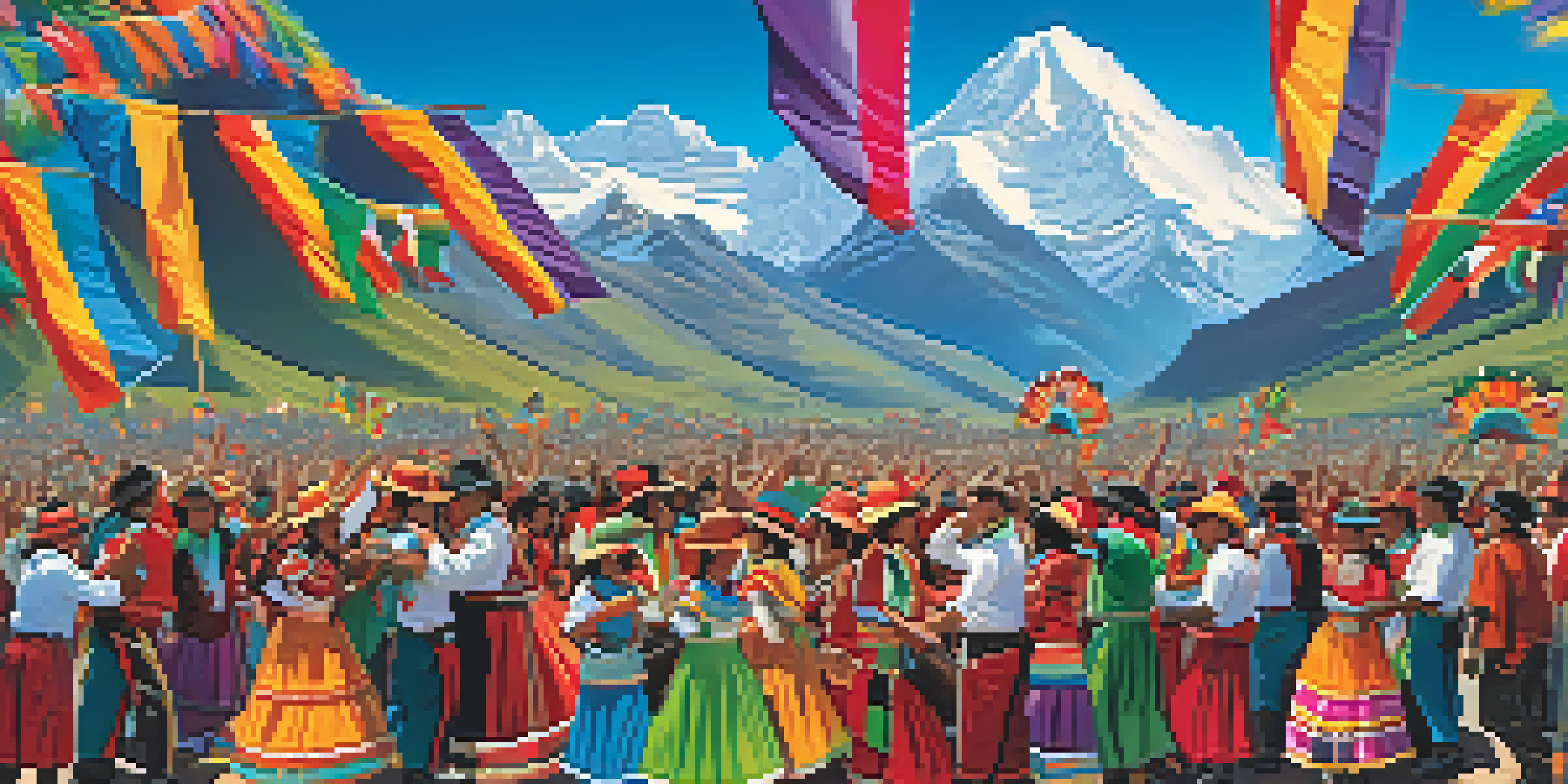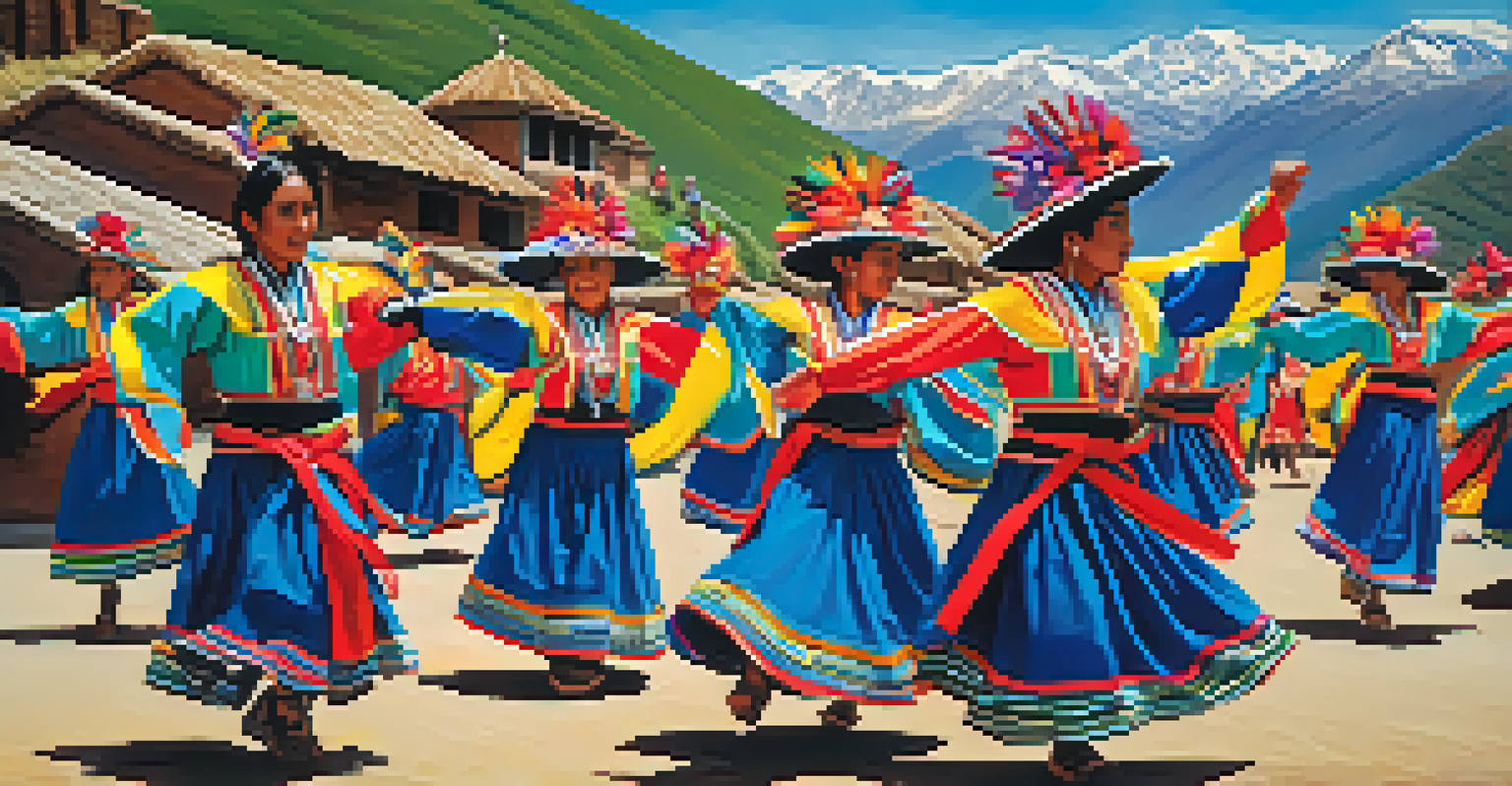Andean Music: Sounds of the High Mountains of Peru

The Roots of Andean Music: A Cultural Tapestry
Andean music is deeply rooted in the diverse cultures of Peru, reflecting a rich history of traditions and influences. This music often combines Indigenous, Spanish, and African elements, creating a unique soundscape that resonates with the high mountains. Instruments like the pan flute, charango, and bombo drum are staples, each contributing to the melodic and rhythmic patterns that characterize the genre.
Music is the shorthand of emotion.
The Andes Mountains themselves play a crucial role in shaping this music, as the altitude and environment influence the sound and style. For instance, the high-altitude communities have developed distinct musical traditions that are often tied to agricultural cycles and spiritual beliefs. This connection to the land and its resources is evident in the lyrics and themes prevalent in Andean songs.
Through storytelling and communal participation, Andean music becomes a vessel for cultural expression and preservation. It serves not only as entertainment but also as a means to pass down history, rituals, and values from one generation to the next, creating a living tapestry of sound that embodies the spirit of the Andes.
Instruments of the Andes: The Sound Makers
The hallmark of Andean music is its vibrant array of instruments, each with its own unique voice. The pan flute, or 'siku', is perhaps the most iconic, made from a series of bamboo tubes tied together, producing haunting melodies that echo through the valleys. The charango, a small string instrument traditionally made from the shell of an armadillo, adds a bright, cheerful strumming that complements the flutes beautifully.

Percussion instruments like the bombo drum provide the driving rhythms that pulse through many Andean songs. Often made from wood and animal skin, the bombo's deep, resonant sound is essential for dance music, encouraging foot stomping and lively celebrations. These instruments together create a rich, layered sound that captivates listeners and invites them to join in the experience.
Andean Music: A Cultural Fusion
Andean music blends Indigenous, Spanish, and African influences, creating a unique sound that reflects the region's rich cultural heritage.
In recent years, modern interpretations and fusions have emerged, introducing electric guitars and synthesizers into traditional Andean music. This evolution showcases the genre's adaptability and appeal to younger audiences, ensuring that its vibrant sound continues to thrive in a contemporary context while still paying homage to its historical roots.
The Role of Dance in Andean Music
Dance is an integral part of Andean music, with many traditional songs designed specifically to accompany various dances. Each dance tells a story, often depicting the daily lives of the people or celebrating significant events. Dances like the 'huaylas' or 'sikuri' are not just performances; they are communal activities that bring people together in joy and solidarity.
Where words fail, music speaks.
During festivals and celebrations, music and dance intertwine, creating a vibrant atmosphere filled with energy and enthusiasm. The colorful costumes worn by dancers, often adorned with intricate patterns, enhance the visual spectacle, making these events a feast for both the ears and the eyes. This combination of music and dance fosters a sense of identity and belonging among community members.
Moreover, dance serves as a form of social commentary, reflecting the struggles and triumphs of the Andean people. Through rhythm and movement, dancers express their connection to their heritage, making music a powerful medium for cultural storytelling. This dynamic relationship between music and dance keeps traditions alive and fosters a rich sense of community.
Andean Music Festivals: A Celebration of Culture
Andean music festivals are vibrant events that showcase the richness of this cultural heritage. Festivals like 'Inti Raymi' and 'Fiesta de la Candelaria' draw thousands of visitors, both local and international, eager to experience the music, dance, and traditions firsthand. These celebrations often include competitions, workshops, and performances that highlight the talents of various artists and ensembles.
Participants in these festivals dress in traditional attire, creating a colorful and lively atmosphere that immerses attendees in the culture. The sense of unity and pride is palpable as communities come together to celebrate their shared history and values. The music played during these events serves as a reminder of their roots and the importance of preserving their cultural identity.
Instruments Shape Andean Sound
Traditional instruments like the pan flute and charango contribute distinctive melodies and rhythms, vital to the genre's vibrant character.
In addition to traditional performances, many festivals also embrace contemporary interpretations of Andean music, allowing for a blend of old and new. This fusion creates a dynamic experience that appeals to a diverse audience, ensuring that the spirit of Andean music continues to evolve while remaining grounded in its historical significance.
The Influence of Andean Music on Global Sounds
Andean music's captivating melodies and rhythms have transcended geographical boundaries, influencing a variety of music genres around the world. Artists from different backgrounds have drawn inspiration from Andean sounds, incorporating elements into pop, world music, and even jazz. This cross-pollination of styles highlights the universal appeal of Andean music, inviting new audiences to explore its beauty.
Collaborations between Andean musicians and artists from other genres have become increasingly common, resulting in innovative and exciting musical fusions. For example, blending traditional Andean instruments with electronic music or hip-hop has created fresh sounds that resonate with younger generations. This evolution showcases the versatility of Andean music while maintaining its core essence.
Moreover, the rise of global music festivals has provided a platform for Andean musicians to reach wider audiences. Events like the WOMAD and GlobalFest not only celebrate diversity but also promote cultural exchange, allowing Andean artists to share their stories and sounds with the world. This exposure helps to preserve and promote Andean music, ensuring it remains a vibrant part of the global musical landscape.
Learning Andean Music: A Journey of Discovery
For those interested in exploring Andean music further, there are numerous opportunities to learn about its rich traditions. Many music schools and cultural institutions in Peru offer workshops and classes focused on traditional instruments, singing, and dance. These educational experiences provide hands-on opportunities to connect with the music and the culture behind it.
Online resources and tutorials have also made learning Andean music more accessible than ever. Videos and instructional content allow aspiring musicians to delve into the techniques of playing instruments like the pan flute or charango at their own pace. This democratization of knowledge encourages a wider appreciation and understanding of Andean music across the globe.
Dance and Music in Community Life
Dance is a central element of Andean music, fostering community solidarity and serving as a medium for cultural storytelling.
Participating in community events, festivals, or even local meet-ups can also be a fantastic way to immerse oneself in Andean music. Connecting with musicians and enthusiasts fosters a sense of community and support, making the learning process enjoyable and enriching. Embracing this journey opens doors to not only mastering the music but also gaining a deeper appreciation for its cultural significance.
The Future of Andean Music: A Vibrant Continuation
As Andean music continues to evolve, its future looks bright. Younger generations are embracing their musical heritage while also experimenting with new sounds and styles. This blend of tradition and innovation ensures that the essence of Andean music remains alive and relevant in a rapidly changing world.
Cultural initiatives and organizations are working tirelessly to promote Andean music, both locally and internationally. These efforts include supporting artists, organizing events, and providing platforms for emerging talents to showcase their work. Such initiatives are vital in keeping the music vibrant and fostering a sense of pride within the communities.

Ultimately, the future of Andean music lies in its ability to adapt while staying true to its roots. By continuing to celebrate and share its unique sounds, Andean music will not only endure but thrive, captivating hearts and minds for generations to come.